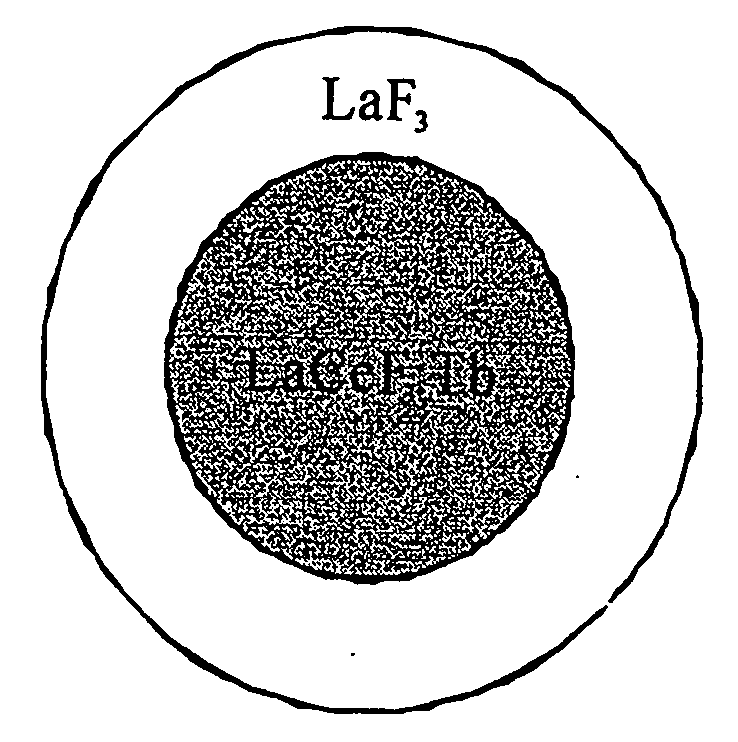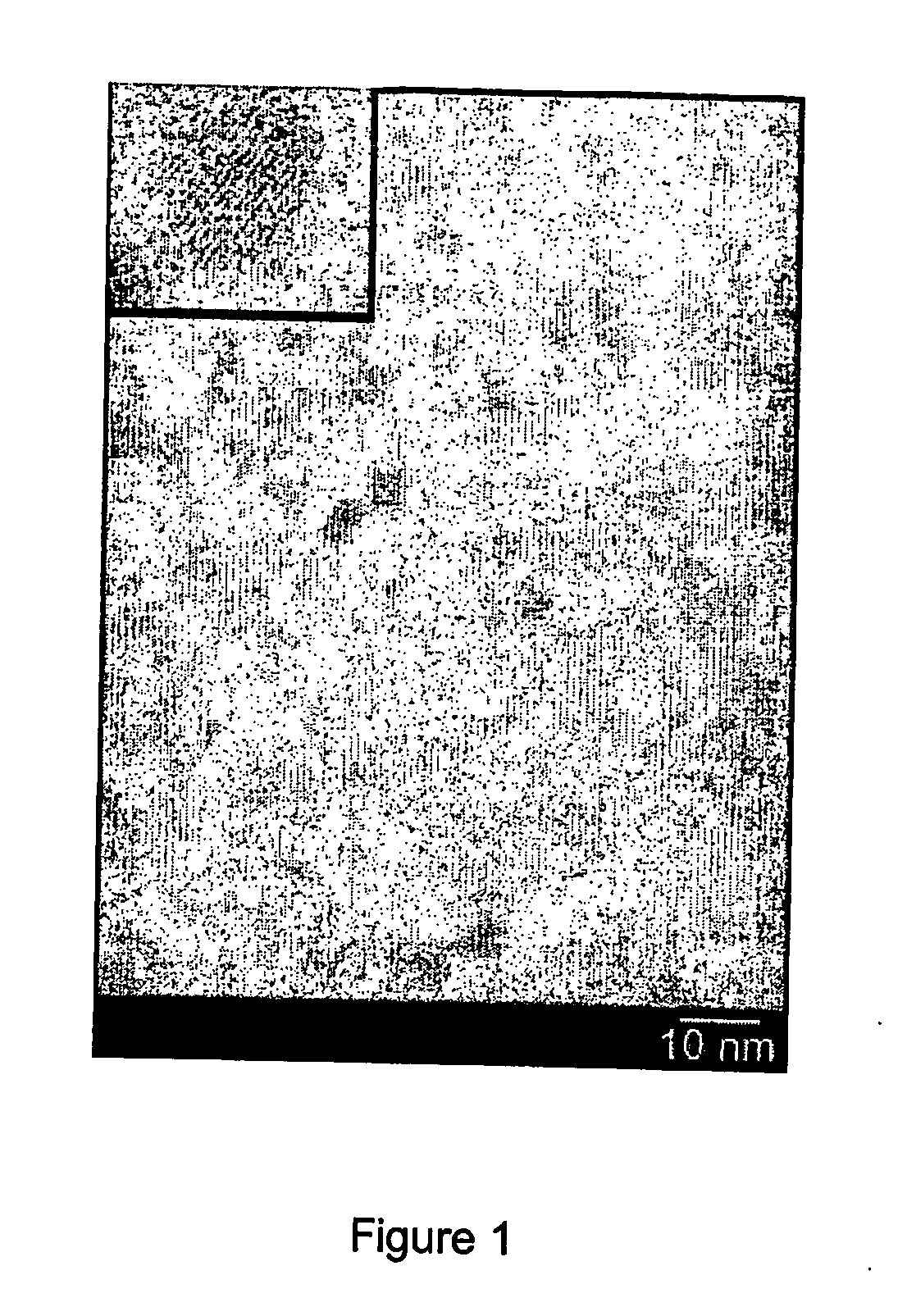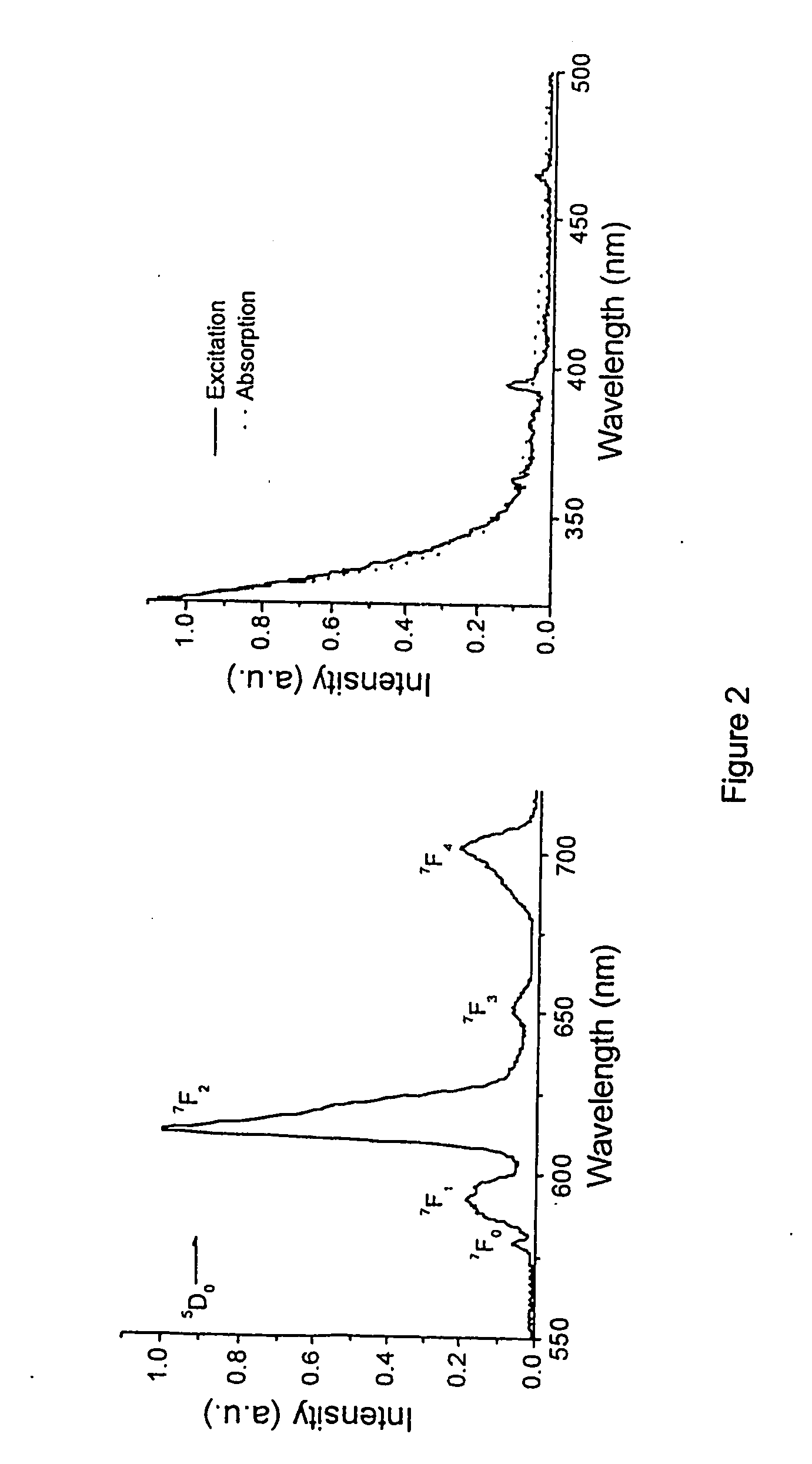Lanthanide (III) - Doped Nanoparticles And Their Applications
a technology of doped nanoparticles and lanthanide, which is applied in the field of lanthanidedoped nanoparticles, can solve the problems of high integration costs of optical components that can even exceed the fabrication costs of components themselves, low-loss windows, and high cost of glass fibre technology, and achieve the effect of reducing quenching
- Summary
- Abstract
- Description
- Claims
- Application Information
AI Technical Summary
Benefits of technology
Problems solved by technology
Method used
Image
Examples
example 1
[0136] Characterization of Eu3+ doped nanoparticles. The nanoparticles of TiO2:Eu were characterized by TEM, by evaporating a drop of a nanoparticle solution on a carbon coated copper grid. A typical picture of nanoparticles obtained by heating the reaction mixture for 30 min is shown in FIG. 1. The picture shows small particles with low contrast, due to the small size of the nanoparticles and the low atomic weight of the Ti and O atoms. The nanoparticles were between 3-5 nm in size and in some nanoparticles lattice fringes can be seen, indicating that they are crystalline. The inset shows an enlargement of such a crystalline nanoparticle in which the lattice planes are more clearly observed. The size of the nanoparticles was similar to the sizes found for un-doped TiO2 nanoparticles synthesized using the same method.
[0137] The composition of the nanoparticles was measured using X-ray fluorescence (XRF). For a sample synthesized with a molar ratio of Eu3+ to Ti4+ of 1:17.7 and a re...
example 2
[0145] Quenching in lanthanide doped TiO2 nanoparticles. The quenching routes of the lanthanide ion in the TiO2 nanoparticles were investigated to explain the low quantum yield. Residual OH groups at the surface of the nanoparticles or in the core of the nanoparticles can quench the luminescence of the lanthanide ion. An FT-IR spectrum was measured to see if water or OH groups are present in the product (FIG. 4). The nanoparticles were dried over P2O5 to remove any physisorbed water present on the nanoparticles surface after the synthesis.
[0146] A broad band centered at 3300 cm−1 was found, which can be ascribed to the OH stretching vibration. The peaks at 2925 cm−1 and 2850 cm−1 are due to stretching vibrations of the CH bonds of the TOPO ligand, together with the PO band around 1046 cm−1. The band around 500 cm−1 is caused by TiO bonds in the TiO2 host. To investigate the effect of quenching by OH impurities, the nanoparticles were also synthesized by using deuterated solvents. N...
example 3
[0148] Lanthanide ions emitting in the Near Infrared. Other lanthanide ions were also successfully doped in the TiO2 nanoparticles. The emission and excitation spectra of TiO2 nanoparticles doped with the NIR emitting lanthanide ions Nd3+, Er3+, and Yb3+ are shown in FIG. 6.
[0149] After excitation above the TiO2 band gap, the emission spectra show the typical luminescence of these lanthanide ions. The Nd3+ ion emits at 880, 1060, and 1330 nm originating from the 4F3 / 2→4IJ (J=9 / 2, 11 / 2, 13 / 2) transitions, respectively. The Er3+ ion emits at 1530 nm from the 4I13 / 2→4I15 / 2 transition and the Yb3+ ion at 980 nm from the 2F5 / 2→2F7 / 2 transition. The excitation spectra show the same broad band starting at 350 nm the same as for the TiO2:Eu3+ particles proving that sensitized emission of these ions also occurs. At high particle concentrations of 50 mg / ml, the excitation spectra also show the direct excitation of Er3+ and Nd3+, because the lanthanide absorption lines become visible in the e...
PUM
| Property | Measurement | Unit |
|---|---|---|
| telecommunication wavelengths | aaaaa | aaaaa |
| telecommunication wavelengths | aaaaa | aaaaa |
| pump power | aaaaa | aaaaa |
Abstract
Description
Claims
Application Information
 Login to View More
Login to View More - R&D
- Intellectual Property
- Life Sciences
- Materials
- Tech Scout
- Unparalleled Data Quality
- Higher Quality Content
- 60% Fewer Hallucinations
Browse by: Latest US Patents, China's latest patents, Technical Efficacy Thesaurus, Application Domain, Technology Topic, Popular Technical Reports.
© 2025 PatSnap. All rights reserved.Legal|Privacy policy|Modern Slavery Act Transparency Statement|Sitemap|About US| Contact US: help@patsnap.com



